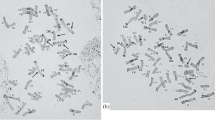Summary
1. Incidence, variability and transmission of aneuploidy were investigated. The material used was the 25th generation of barley in which Freisleben, in 1938, had induced tetraploidy by Randolph's method.
2. There was only little variability in the frequency of aneuploids over a period of three years. Our relatively old material showed about the same amount of aberration (40–45%) as was found by other workers in younger 4 x-barley generations.
3. No correlation was observed between ear fertility and frequency of aneuploidy in the progeny. The known tendency of increasing aneuploidy with decreasing kernel weight was confirmed by our results (table 5). The interindividual variability of aneuploidy frequency (measured on 54 spike descendants) ranged from 6 to 73% (table 2).
4. Progeny tests on euploid plants derived from spikes with different aneuploidy frequencies showed no specific mode of transmission (table 3), and efforts to select have remained unsuccessful.
5. The high percentage of aneuploid seeds is, in our opinion, responsible for the low productivity of tetraploid barley. The discussion is concerned with problems regarding the reduction of these types by screening out small seeds or by means of cytological selection for low aneuploidy frequency.
Zusammenfassung
1. An einem etwa 25 Jahre lang bearbeiteten, im Jahre 1938 von Freisleben durch Hitzeschock induzierten tetraploiden Gerstenmaterial wurden Untersuchungen über das Ausmaß, die Variabilität und die Weitergabe von aneuploiden Typen durchgeführt.
2. Die Aneuploidenfrequenz variierte in drei Versuchsjahren nur geringfügig und hatte bei unserem relativ alten Zuchtmaterial mit etwa 40–45% das gleiche Ausmaß, welches auch für jüngere Generationen anderer Herkunft festgestellt worden ist.
3. Zwischen der Einzelährenfertilität und der Aneuploidenhäufigkeit in der Nachkommenschaft besteht keine Korrelation. Die interindividuelle Variabilität der Aneuploidenfrequenz (ermittelt an 54 Ährennachkommenschaften) reichte von 6 bis 73%.
4. Nachkommenschaftsprüfungen an 28chromosomigen Pflanzen aus Ausgangsähren mit unterschiedlich hoher Aneuploidenhäufigkeit zeigten bisher keinen spezifischen Übertragungsmodus, so daß die Selektion erfolglos blieb.
5. Die Möglichkeiten zur Verringerung des Anteils der sich negativ auf den Ertrag auswirkenden aneuploiden Pflanzen durch Siebfraktionierung der Saatware oder über eine cytologische Selektion auf geringe Aneuploidenfrequenz werden diskutiert.
Similar content being viewed by others
Literatur
Banneick, A., und F. Walther: Polyploider Roggen. In: G. Könnecke, Forschungsaufgaben und Feldversuche 1953–1955 des Instituts für Acker- und Pflanzenbau der Martin-Luther-Universität Halle-Wittenberg S. 172–183 (1957).
Freisleben, R.: Untersuchungen an tetraploiden Kulturgersten. Forschungsdienst Sonderheft 16, 361–364 (1942).
Greis, H.: Vergleichende physiologische Untersuchungen an diploiden und tetraploiden Gersten. Der Züchter 12, 62–73 (1940).
Helgason, S. B., and M. Rommel: Seed development in relation to aneuploidy in autotetraploid Hordeum vulgare L. Canad. J. Genet. Cytol. 5, 189–196 (1963).
Krolow, K.-D.: Aneuploidie und Fertilität bei amphidiploiden Weizen-Roggen-Bastarden (Triticale). I. Aneuploidie und Selektion auf Fertilität bei oktoploiden Triticale-Formen. Z. f. Pflanzenz. 48, 177–196 (1962).
Morrison, J. W., and T. Rajhathy: Chromosome behaviour in autotetraploid cereals and grasses. Chromosoma (Berlin) 11, 297–309 (1960).
Müntzing, A.: Experiences from work with induced polyploidy in cereals. In: Svalöf 1886–1946, p. 324–337 (1948).
Müntzing, A.: Cyto-genetic properties and practical value of tetraploid rye. Hereditas 37, 17–84 (1951).
Plarre, W.: Vergleichende Untersuchungen an diploidem und tetraploidem Roggen (Secale cereale L.) unter besonderer Berücksichtigung von Inzuchterscheinungen und Fertilitätsstörungen. Z. f. Pflanzenz. 33, 303–353 (1954).
Reinbergs, E., and L. H. Shebeski: Fertility of barley autotetraploids. I. Fertility in successive generations of four autotetraploid barley varieties and the effect of selection for fertility in the O.A.C.21 autotetraploid. Canad. J. Pl. Science 39, 98–107 (1959).
Reinbergs, E., and L.H. Shebeski: Fertility of barley autotetraploids. II. The relationship of aneuploidy, dwarfing and fertility in four autotetraploid barley varieties. Canad. J. Pl. Science 41, 124–133 (1961).
Riley, R.: The diploidisation of polyploid wheat. Heredity 15, 407–429 (1960).
Rommel, M.: Aneuploidy, seed set and sterility in artificially induced autotetraploid Hordeum vulgare L. Canad. J. Genet. Cytol. 3, 272–282 (1961).
Rosendahl, G.: Cytologische Untersuchungen an tetraploiden Gersten. Kühn-Archiv 60, 238–252 (1944).
Smith, L.: Cytology and genetics of barley. Bot. Rev. 17, 1–51, 133–202, 285–355 (1951).
Smith, W. E.: Fertility of autotetraploid varieties and hybrids of barley. Canad. J. Pl. Science 40, 434–442 (1960).
Tjio, J. H., and A. Levan: The use of oxychinoline in chromosome analysis. Anal. Estac. Exper. Aula Dei 2, 21–64 (1950).
Walther, F.: Fertilitätsuntersuchungen beim Roggen. Z. f. Pflanzenz. 41, 1–32 (1959).
Author information
Authors and Affiliations
Additional information
Ständige Anschrift: Institut f. Weizen- und Sonnenblumenzüchtung der Bulgarischen Akademie der Wissenschaften, General Toschewo, Bez. Tolbuchin.
Rights and permissions
About this article
Cite this article
Mettin, D., Tschawdaroff, G.A. Untersuchungen über die Häufigkeit und Weitergabe aneuploider Typen bei autotetraploider Gerste. Zuchter \ Genet. Breed. Res. 36, 98–103 (1966). https://doi.org/10.1007/BF00445471
Issue Date:
DOI: https://doi.org/10.1007/BF00445471




